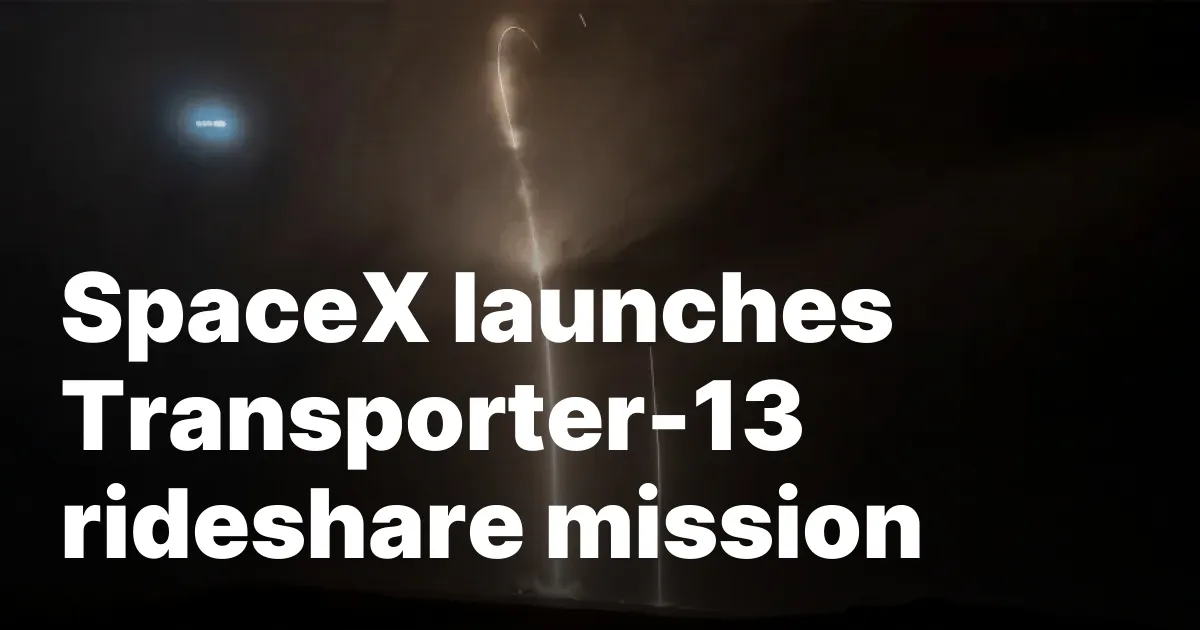
On March 15, 2023, at 2:43 a.m. Eastern Time, a SpaceX Falcon 9 rocket successfully lifted off from the Vandenberg Space Force Base in California, marking the commencement of the Transporter-13 mission. This launch is part of SpaceX's ongoing series of dedicated rideshare missions, which have significantly transformed the landscape of the small satellite industry. The Transporter-13 mission follows the launch of the Crew-10 mission from the Kennedy Space Center and precedes another launch of Starlink satellites from Cape Canaveral, showcasing SpaceX's capacity for rapid deployment.
SpaceX reported that the Transporter-13 mission successfully carried a total of 74 payloads, including both hosted payloads and satellites that will be deployed later using an orbital transfer vehicle provided by D-Orbit. Over a span of 90 minutes, SpaceX's website outlined plans for 47 separate deployments, further emphasizing the mission's complexity and efficiency.
This recent launch featured a diverse mix of new and returning customers from both government and industry sectors. Notably, Spire deployed seven of its Lemur satellites, while Iceye introduced four additional synthetic aperture radar (SAR) satellites, including its first "Gen4" satellite, which boasts an antenna double the size of its predecessor and enhanced power capabilities.
Also featured on the Transporter-13 mission was Varda Space Industries, which successfully launched its third orbital processing and return capsule mission, designated W-3. This mission follows the launch of W-2 on Transporter-12 in January, with the W-3 capsule also scheduled to land in Australia after a brief period in orbit, where it will test an inertial measurement unit for the U.S. Air Force.
Among first-time participants, Albedo launched its inaugural satellite, Clarity-1, designed to operate in low Earth orbit and provide high-resolution imagery of up to 10 centimeters. Additionally, IOD-1, the first satellite from Startical, a European startup, was launched to support aircraft communications over polar and oceanic regions. This 25-kilogram satellite was constructed by GomSpace.
MuonSpace also made its debut with the launch of its FireSat Protoflight satellite, a prototype designed for its upcoming constellation aimed at wildfire monitoring. NASA utilized the Transporter-13 mission to deploy the Electrojet Zeeman Imaging Explorer (EZIE), a space science mission featuring three 6U cubesats that will work in formation to map electrical currents associated with auroras in the upper atmosphere. Larry Kepko, EZIE mission scientist at NASA’s Goddard Space Flight Center, stated, “EZIE will help us understand how these currents form and evolve, at scales we’ve never probed.”
The ongoing success of SpaceX's Transporter series of rideshare missions to sun-synchronous orbit, along with their newer Bandwagon missions targeting mid-inclination orbits, highlights the high demand among satellite developers. However, this trend has raised concerns among small launch companies, who argue that the competitive pricing of SpaceX's rideshare missions makes it difficult for them to operate sustainably. Stella Guillen, chief commercial officer of Isar Aerospace, noted during the Satellite 2025 conference, “Cost is still an issue because you have a player that has dropped costs tremendously.”
Marino Fragnito, chief commercial officer at Avio, which developed the Vega C rocket, emphasized the impact of SpaceX's pricing strategy. He stated, “Why is there a market for smallsats today? Because there’s a price of $6,000 per kilogram. Otherwise, this market would not exist.” He pointed out that the current pricing practices could undermine the viability of other launch companies.
Despite these challenges, many companies, including Iceye and Spire, continue to rely on rideshare missions to develop and maintain their satellite constellations. Some launch providers argue that while rideshare missions are advantageous for initial satellite deployments, companies may eventually shift to dedicated launches for greater control over their orbits and schedules. Peter Beck, CEO of Rocket Lab, echoed this sentiment after the successful launch of his company's Electron rocket. He noted that all of Rocket Lab's launches this year have focused on expanding satellite constellations, showcasing the demand for flexibility and customization in satellite deployment.
The Transporter-13 mission exemplifies the dynamic and rapidly evolving nature of the small satellite industry, driven by innovative technologies and competitive pricing strategies. As the demand for satellite launches continues to grow, SpaceX's rideshare missions will remain a pivotal player in shaping the future of space exploration and satellite deployment.